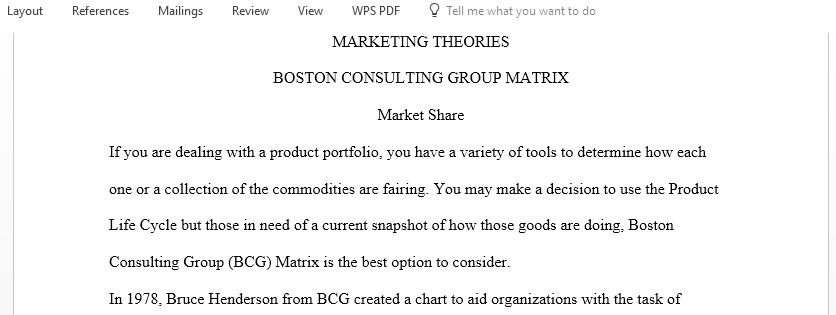Boston Consulting Group growth-Share Matrix
B. The Boston Consulting Group (BCG)
a. BCG Growth-Share Matrix (Strategic Considerations)
Market share
b. Each quadrant shows a ‘strategic imperative. That is a strategic issue that must be considered in the formulation of the competitive strategy associated with firms whose characteristics fall within that quadrant.
i. STAR: Cash is not going to grow as fast as A/R, Inventory, and non-current assets. Accordingly, the concern for cash is paramount. (That is why Stars have “exit strategies”….to raise cash.) Refer to Appendix “B”
- Frequently, a STAR is, a “start up” and therefore a smaller firm.
Accordingly: 1
a. They have no scale economies
b. And worse: possibly low entry barriers (effective life of an American patent is about 3 years)
Structural Characteristics
- c. Technological uncertainty (both product and process) Bob K’s bio-fuels (paraffin)
d. Strategic uncertainty: who are the actual or prospective competitors?
e. High initial costs…but (hoped for) steep cost reductions from being at the early stages of the learning curve
f. First time buyers (product unfamiliarity….no de-bugging)
g. Short time horizon (necessary because of limited resources) Problems dealt with expeditiously
h. Impact of subsidies (Adds to the risk as subsidies are not market driven)
- Mobility barriers often serve as entry barriers for the STAR
a. Proprietary technology (Keeping it…Jim Ryan effect)
b. Access to distribution
c. Access to supply (labor, materials, financing)
d. No cost advantages…no scale, operating leverage, learning - Risk: raises costs…particularly of capital
a. Skilled labor: trade off equity
b. Material: inability to enjoy volume…or trade credit
c. Entrepreneurs are by definition risk adverse (contrary to popular mythology)
ii. CASH COW: Feed surplus cash to the STAR…..or return it to the shareholders.
The idea is to ensure that the firm’s investment needs are properly addressed so it can maintain its market share leadership, prior to utilizing cash for other purposes.
- Typical Characteristics: of a CASH COW
a. Very formal structure….hierarchical
b. Figurehead duties critical : dealing with political establishment and large customers
c. CYA leadership, risk adverse, lots of “use of consultants”
d. Need for stable environment (operating leverage)
e. Has the characteristics of a cost driven generic strategy….because of resource mobility (I/O)
f. Oligopolistic Markets….game theory - Sounds uncomplimentary, but you have to play the hand that you are dealt!
a. Strong tendency to emphasize diagnostic controls (easy to receive bonus payments)
b. Standardization (SOP’s)
c. Job Descriptions - Problems get “bumped up”…..screened
- Extrapolate existing strategy….nothing radical
- Change almost always driven by crisis….frequently calling for a “Shaker” management style
- Learning (Experience) Effect
a. Labor efficiency arises from repetition
b. Work specialization
c. Getting better production equipment performance
d. Changes in resources (Less expensive substitute materials)
e. Product standardization
f. Product redesign - Flexible manufacturing can change this paradigm
a. First 2010-Honda right after the last 2009 Honda (Marysville)
b. Nikko Wolverine (Continuous Improvement…path dependant intangible asset)
c. Exelon….24 day refueling of nuclear reactors - iii. DOG: We enter an additional 2×2 Matrix to evaluate the completive position of the firm considering the firm’s competencies, and the industry exit barriers.
- iv. PROBLEM CHILD: The issue here is that there are a multiple of acceptable strategic imperatives, so the strategist has to select one of the options. These options are environmentally (PESTI/DIRT) dependant.
- Sell to a larger competitor
- Buy a competitor to gain market share
- Initiate a “Significant Competitive Action”
- Change to a Focused Strategy (Cost or Differentiation based)
- Change to a Differentiation Strategy
Answer preview for Boston Consulting Group growth-Share Matrix

Access the full answer containing 570 words by clicking the below purchase button
